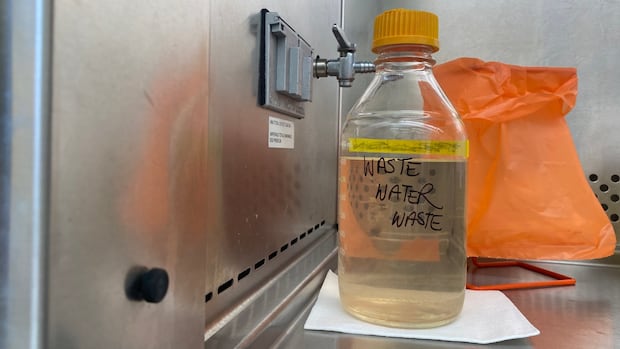When Brittany Ramsey started experiencing “awful stomach episodes” she thought it must’ve been side effects of the medication she was taking to manage her diabetes.
But after a particularly gruelling episode where she just could not stop vomiting — not being keep down even small sips of water — that landed her in hospital, Ramsey knew something felt different about what she was experiencing.
“From then, the episodes got worse and worse, and closer together,” said Ramsey, a 35-year-old operations trainer at a financial firm in Cincinnati, Ohio. “From 2021 to 2024 … three years, I was hospitalized 29 times. Five ambulance trips – one actually had to pick me up on the side of the road because I couldn’t make it to the hospital.”
After years of undergoing, at times, invasive testing procedures to rule out Crohn’s disease, gastroparesis and diverticulitis, a doctor told Ramsey about cannabis hyperemesis syndrome (CHS).
In recent years some emergency rooms have been seeing an uptick in visits due to cyclic episodes of uncontrollable vomiting in cannabis users, often characterized by experiencing temporary relief with hot showers and baths. Since it was first identified in medical literature in 2004, CHS cases have increased, possibly because of greater cannabis access or higher THC potency of products.
Public health researchers suggest more awareness of CHS within the health-care system is needed for cannabis users to get the information and support they need.
More CHS cases in the ER
CHS is characterized by “severe and persistent vomiting” and is usually seen in people who have been using cannabis several times a week for multiple years, said Jamie Seabrook, a professor at the Department of Epidemiology and Biostatistics at Western University in London, Ont.
Ramsey said she’d been smoking at least once a day for over 10 years since she was 18 when she first started experiencing CHS symptoms in 2017.
A 2022 study by researchers at the Ottawa Hospital Research Institute looked at the rate of emergency department visits for CHS after recreational cannabis was legalized and commercialized in Ontario, looking at nearly 13,000 CHS-related hospitalizations in Ontario from 8,140 individuals between 2014 and 2021.
The study, published in the Journal of the American Medical association (JAMA), found that emergency department visits related to CHS had increased by 13-fold over a period of nearly eight years. The study doesn’t show what caused the change, but the authors noted that the biggest increase in visits came not after legalization in 2018 but after Ontario allowed expansion of retail stores in 2020, which coincided with the COVID-19 pandemic.

Though we don’t have numbers how many people have been diagnosed or hospitalized with CHS, online communities are filled with people looking for support.
Ramsey is part of one of them — a CHS Facebook group described as a “safe place to recover and learn” with 3,000 members. The largest CHS Facebook group has 31,000 members. On Reddit, the group r/CHSinfo has 20,000 members, with discussions ranging from tips on how to manage episodes and personal anecdotes about repeated hospitalizations.
Seabrook, who co-authored a recent review of existing research on CHS in youth, said there’s been an “explosion” of people showing up in some North American emergency rooms with CHS within the last seven to eight years.
The Ottawa Hospital Research Institute study showed that other cannabis-related emergency room visits, including for intoxication and dependence, saw a substantial increase starting in early 2020 as well.

Surge in THC potency since the 1980s
Seabrook said a likely reason for increased rates of CHS is the high THC potency of cannabis products today.
THC is the compound in cannabis that is responsible for the sensation of a high most people experience when consuming it. When its potency increases, so do its harmful effects.
Different strains of the plant will have different concentrations of active compounds, measured by percentage of total weight or volume. On average, THC content is much higher today than it used to be.
“The potency of THC was only about three per cent in the 1980s and today, according to Health Canada, the average is 15 per cent with some strains as high as 30 per cent,” Seabrook said, citing Health Canada numbers for “fresh or dried herb material.”
“So we’re talking a 400 per cent or higher increase in the potency.”

For “chemically concentrated extracts,” such as hash oil, shatter, budder and wax, the typical potency can be up to 90 per cent, according to Health Canada data.
“The potency, I think, is what’s causing the illnesses to become more and more prevalent, because they’re smoking a lot more potent stuff,” Ramsey said. “And that’s the same with me. When I first started smoking, it was my brother’s homegrown stuff, versus getting it from friends and dispensaries out in California, where it does get stronger and stronger.”
“I feel like maybe before just making marijuana available to the masses, maybe some of these things should have been looked into. You know, too much of anything might be bad,” said Ramsey.
Lawsuit against Aurora Cannabis cites CHS
A lawsuit was recently brought against Canadian cannabis production company Aurora Cannabis for alleged negligence of failing to warn consumers about the potential risk for developing CHS from the regular use of its products. The lawsuit was certified by the Ontario Superior Court of Justice last month, meaning it can proceed as a class action.
Margaret Waddell, the lawyer prosecuting the case, said she hopes that if the lawsuit is successful, it could have an industry-wide effect on including CHS in their product labelling.
“Ideally, Health Canada will require them at some point,” Waddell said. Health Canada does require cannabis manufacturers to warn customers about specified risks — including psychotic symptoms, addiction and dependence — but Waddell said there aren’t currently any requirements to specifically include CHS in those warnings.
Aurora Cannabis declined to comment on the lawsuit, writing in an emailed statement: “It is the company’s practice not to comment on legal matters beyond information that is made available to the public.”
“Information that [CHS] exists is very important,” Seabrook said. “In schools, in health-care settings – whether that’s neurologists, psychiatrists, [emergency room] doctors – and public health campaigns, so people can make a better informed decision about their cannabis use.”






